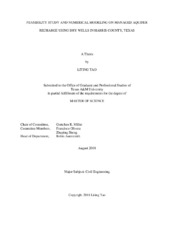| dc.description.abstract | Managed aquifer recharge (MAR) has been adopted as a modern water management strategy to store water into subsurface during surplus periods for future recovery. As one application of MAR, dry well is installed in vadose zone and can be used to facilitate infiltration of recharge water through an unsaturated formation into the underlying aquifer. In this study, we investigated the feasibility of applying dry wells in Harris County, Texas. Harris County is located in southeastern Texas and contains Houston, the fourth largest metropolitan area in the US. The county suffered both severe floods and droughts in recent years, including Hurricane Harvey in 2017, and drought in record in 2011.
This project was performed in two phases. Phase 1 consists of feasibility study, in which the suitable recharge locations were investigated based on existing data. Phase 2 focuses on modeling the dry well performance using HYDRUS 2D, for a range of soil conditions and physical configurations, to assist in developing guidelines for dry well design and its application in Harris County.
In feasibility study, central portions of Harris County were identified to be suitable for dry wells. Following low impact development (LID) concept, which aims to reduce runoff near the source, dry wells are recommended to be placed near existing retention basins. In model simulations, three saturated hydraulic conductivities (Kvsat) of soils from targeted sites were incorporated (0.24 m/d, 0.47 m/d, and 0.78 m/d). Aiming for an extensive investigation on the controlling factors, the well length, duration of injection, separation distance between dry well and water table, multiple injections, antecedent soil moisture, Kvsat, natural recharge, location of clay lens, and tracer movement, were addressed in modeling process. The model suggests dry wells are most appropriate for regions with a deep groundwater table, if the high recharge rate is of the uppermost concern. High antecedent soil moisture can result in slow water movement and limited storage capacity. In certain areas, injecting several days after the peak storm is preferred if timed operation is possible. Prior to dry well construction, location and size of subsurface clay lens should be identified to avoid negative impact from clay lens. Contaminant fate and transport tests are recommended to determine the minimum separation distance for various ranges of soil Kvsat. | en |


